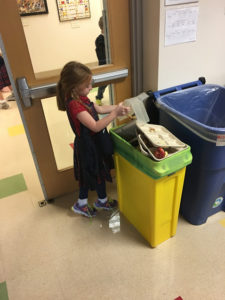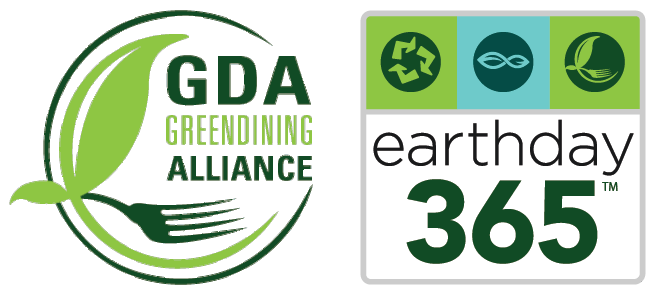The crocuses and daffodills are blooming, signaling the ressurection of the most anticipated food-event of the Spring: fish fry season! Unfortunately, many parishes serve their tasty golden wares on Styrofoam – a non-recyclable material that wreaks havoc on ecosystems.
Some parishes are making the effort to reduce the environmental impact of their fish frys – parishes like Holy Redeemer in Webster Groves. Holy Redeemer has gone further than simply refusing to use Styrofoam for their school lunches and annual fish fry -they’ve blown their competition out of the water by committing to a Low Waste fish fry!
Putting on a Low Waste event takes lots of planning to ensure that very little winds up in a landfill. Most of this work is done at the “frontloading” stage – in an ideal situation, all plates, cutlery, and cups would be re-usable. This isn’t practical or possible for every event, however, and planners must get creative to solve their waste problem. For example, Holy Redeemer does not have the space to store and clean re-usable supplies, so they must use disposables instead. Luckily, they are thoughtful about their disposable purchases, and have decided to purchase all compostable and recyclable materials to serve their patrons.
Fried fish and tasty sides will be served on compostable clamshells containers, accompanied by compostable cutlery, and drinks will be served in recyclable cups – the napkins and extra food will be composted with the clamshells and the cutlery. While their event won’t quite qualify as Zero Waste, they are working towards this goal in coming years. Sustainability is a journey, after all, and Holy Redeemer has made a commitment to doing a better job every year to reduce their waste.
Student and faculty volunteers will educate patrons on where to place their leftovers and disposables after they eat. Informational signs about the benefits of composting will be strategically placed along the line for the fish fry, helping to reach parents and community members who have not enjoyed the environmental training and experience of the students in the Green Machines program, a student-led green team at Holy Redeemer.

Informational signs will be on display along the line of the fish fry.
Teacher and planeteer Jamie Hasemeier helped to start the Green Machines program, designed for students from 4th-8th grade, about 3 years ago. The Green Machines meet monthly to brainstorm about ways to help their school to become more sustainable and increase awareness about environmental issues, including creating educational videos for their peers. One of the ways that Holy Redeemer has reduced its impact is through participating in the US Green Building Council Missouri‘s Green Schools Quest, where they took a first place prize for their video about reducing idling on campus.

The Green Machines taking a tour of a composting facility to better understand the food-to-soil cycle.
The Green Machine has been an impressive addition to Holy Redeemer, with a lengthy list of action items that range from incorporating single-stream recycling into their institution, creating educational events like Waste Free Wednesday, participating in Earthway’s Center‘s LEAP program (Leadership in Environmental Action Projects), building a raised bed garden, creating a winter garden, promoting a “walk/roll to school” day, and visiting a compost facility to better understand how food scraps are given a new life as healthy soil.

A student diligently sorts out compost from recyclables.
In addition to the student-led group, Holy Redeemer created Our Common Home Ministry, a parish group with a focus on sustainability. Our Common Home Ministry meets regularly to discuss and address the sustainability needs of the campus. Thanks to the hard work and collaboration between students, faculty, and parishioners, both the school and the parish have been benchmarked for energy efficiency, and all of the lights in the church have been switched to LEDs!
If you’re looking for a fish fry that won’t send you away with Styrofoam, check out the Holy Redeemer’s unique, inspiring, and tasty event – you have two chances to check out their sustainable fish fry: 3/3/2017 and 3/24/2017. Holy Redeemer is located in Webster Groves, at 341 E Lockwood Ave.
UPDATE:
The GDA just learned that St. Louis Earth Day’s own Kathy Dolson helped manage the first Zero Waste fish fry in the area in 2014!
Kathy is St. Louis Earth Day’s Office Assistant, and probably the GDA’s biggest advocate. She got St. Ann to give up styrofoam and colaborated with then-pastor Bill Kempf to move the parish event’s service-ware to compostable plates, cutlery, napkins, to-go boxes and bags. They used bulk condiments to avoid single-serving packets, and they recycled all their bottles and cups!
“(I) couldn’t have done it without the help of Boy Scout Troop 516 and their leaders who bused tables and monitored the waste station to help diners sort their waste,” Dolson explained. Only a small bag of trash – mostly plastic gloves – was taken out every night.
St. Ann’s diversion rate (the amount of waste kept out of landfills) hit 98-99% every week for about 1500 people over 6 weeks of the fish fry.
Dolson was proud to boast that her parish has now switched to real, reusable plates and cutlery! Reusables are always the best option, as even compostables and post-consumer products (preferable for single-use items) take resources to create.




